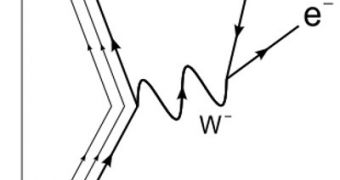When the W and Z bosons were proven to be the mediators of the weak nuclear force, the Standard Model of particle physics received one of the most definitive pieces of evidence in its favor. At the time, all the jigsaws to the puzzle appeared to be falling into place, and physicists were more than happy with the measurements. Now, a group of experts from 19 countries announce that the W boson's width has just been measured again, with increased accuracy. More than 500 physicists have been involved in this effort.
“The W boson is one of the very few major building blocks of matter. It is a member of a family of particles that is the most fundamental in nature. The W boson is responsible for weak interactions, which govern some of the most important processes in nature,” Fermilab scientist Dmitri Denisov tells PhysOrg. He has also been part of the team that has conducted the new measurements. The first results that the group, called the D0 Collaboration, has obtained appear in a paper entitled “Direct Measurement of the W Boson Width,” which is included in the latest issue of the prestigious journal Physical Review Letters.
“Particle physicists are working hard to improve our knowledge of the fundamental particles of nature. We want precision measurements of all these particles, since their properties are important to understand [the] world around us and for calculations used in developing and testing new theories. The W boson is one of those that is worth looking at, because if its role in weak interactions. We wanted to measure the width, because that is directly related to its lifetime,” Denisov explains.
Another reason why these measurements are very important is the fact that the W boson's decay also influences the lifetime of nuclei. Existing theories cover a large number of the boson's decay mode, but Denisov says that there may be modes that have not been hypothetically inferred. The D0 Collaboration believes that direct observations of the elementary particle's width could lead to it detecting and understanding more of these modes. “So with these more precise measurements of the W boson, we can start looking for things that we don’t know yet,” he adds.
The team used the Tevatron particle accelerator at Fermilab in order to conduct the new research. It took it more than three years to gather the amount of pieces of evidence it needed to reach these conclusions. “We had to collect data from the Tevatron, and then analyze it. Scientists worked on developing Monte Carlo simulations to describe the detector performance. As a result, we have been able to come up with a very precise measure of [the] W boson width and lifetime that can be used to develop physics theories and for precision description of world around us,” the expert says.
“This work, is very important for fundamental physics. Quite a few people put years of their lives into this measurement, to gain a better understanding of the forces which governs our world,” he concludes.

 14 DAY TRIAL //
14 DAY TRIAL //